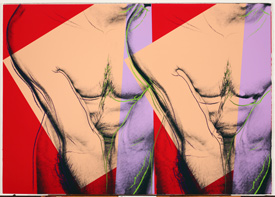In the fall of 1977, Andy Warhol began work on two new series of artworks which would become known as Torsos and Sex Parts. While the Torsos paintings would quickly be praised for following in the “high art” style of classical nudes, the Sex Parts series from which Torsos was borne blurred the line between art and pornography.
In creating the artworks, Warhol was probably inspired by classical nudes and erotic art which have been depicted throughout history. Sexuality in artwork can be found as early as 35,000 BC in central Europe with the erotic sculptures of the Venus of Hohle Fels and later the Venus of Willendorf statuettes, all of which have enlarged breasts and well-defined genitalia. In addition, sexual acts were displayed on vases in Ancient Greece from the 6th Century BC with images of Zeus engaging with his male lover Ganymede, as well as scenes of coitus on Etruscan vases and erotic frescos uncovered in Pompeii. Classical nudes, some homoerotic, are also present in works from the Renaissance, as witnessed in Goya’s Las Maja Desnuda and Titian’s Venus of Urbino. Warhol would have been taught about such historical works during his Art History classes at Carnegie Tech, and their impact is evident in this exhibition.
The seed of the Torsos and Sex Parts series sprouted after a man approached Warhol boasting of his large penis. Warhol agreed to photograph the man’s genitalia and the photographs were placed in a box casually labeled “Sex Parts.” Later, Warhol noticed the wording of the box’s label and conceived the idea for a series of works based on the initial photographs. Subjects for subsequent photo shoots were recruited from gay bath houses by Halston’s boyfriend, the artist and window dresser Victor Hugo. The men were asked to relax, pose, or take part in various sexual activities while Warhol photographed them with a 35mm camera and a Polaroid Big Shot. According to associate Bob Colacello, when confronted on the explicit nature of the photographs sitting around the office Warhol responded, “Just tell them it’s art, Bob. They’re landscapes.” Holy Terror, p. 337
The tamer images became the basis of the Torsos series, which was meant to be exhibited in museums, and which debuted at the Grand Palais in Paris in October 1977. The more sexually-charged artworks were produced as the Sex Parts print portfolio and were intended to be purchased for private collections. But perhaps the underlying reason for their creation was as a tool for Warhol’s ultimate acceptance of his sexuality. Longtime assistant Ronnie Cutrone recalls: “… we always understood it was going to be one of those portfolios that would sit primarily in the back room; that it would take a certain type of collector to appreciate them… But Andy was Catholic and a homosexual…For years, the joke was that Andy called homosexuality a “problem.” Sex Parts was a final announcement or affirmation of his homosexuality.” Unseen Warhol, p.68.
Casually referred to by Warhol as the Cocks, Cunts, and Assholes series, many of the works in this exhibition are on view to the public for the first time.

Andy WarholTorso (Double), ca. 1982, Screenprint on TH Saunders Waterford (Hot Pressed) paper, The Andy Warhol Museum, Pittsburgh; Founding Collection, Contribution The Andy Warhol Foundation for the Visual Arts, Inc.1998.1.2644

